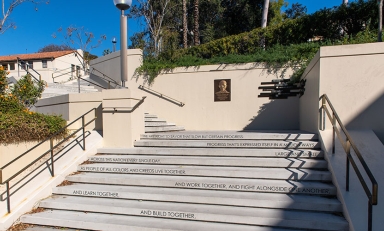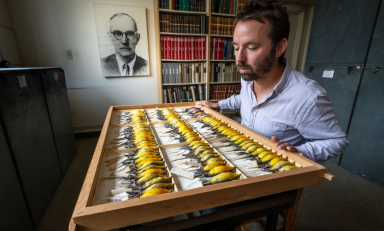Pulitzer Prize-winning New York Times reporter Andrea Elliott ’96 fondly remembers her first day at Oxy, when she nervously knocked on the office door of the campus newspaper, The Occidental.
I came here determined to get on the newspaper," she recalled during her Feb. 20 talk as the College’s Distinguished Alumni Visitor, in Morrison Lounge. "I had amassed my best clips from high school. The editor swung open the door and looked at me in astonishment. Not only was there no selection process, they were amazed that anyone would be showing such enthusiasm. I feel eternally grateful to Occidental for swinging open the door like that."
An English and comparative literary studies major at Oxy, Elliott graduated first in her class from Columbia University’s journalism school in 1999 and soon headed for the Times. After the 9/11 attacks, she became interested in the Muslim community in America and how it was being portrayed in the media.
During her hour-long talk, she shared some of the fruits of her research into Muslims in America before moving on to discuss her award-winning 2006 series, which focused on an imam, or prayer leader, in Brooklyn.
Among her findings: There is no one Muslim community in the United States. With Muslim immigrants coming from a wide variety of countries, from Albania to Senegal, "there is a huge diversity in racial, cultural and theological background," she said. About 30% of American Muslims are immigrants from Southeast Asia; 20% are African American, mostly born here. Black Muslims tend to identify themselves as Muslims who are American; Muslim immigrants as Americans who are Muslim. She also found that only 10% of American Muslims regularly pray in mosques.
Almost seven years after 9/11, mistrust of Muslim Americans persists, Elliott said. She quoted a recent Gallup Poll that found that less than half of Americans think that Muslims are loyal to the United States, and one-fourth wouldn’t want one as a neighbor.
After 9/11, she said, some Muslims distanced themselves from their faith and their communities, while others re-embraced their religious and cultural identity. The media at that time, she said, was "focused on two aspects of the story: the victims and the perpetrators." Elliott sought a broader understanding, which she felt she could only achieve through spending a lot of time with one individual.
She finally found someone willing to trust her with his story—an imam in Brooklyn named Sheik Reda Shata. Imams, Elliott explained, are almost all foreign-born. Scholars, they are the keepers of Islamic heritage and history. Many find themselves in the unexpected position of community leader when they get to their Muslim neighborhoods in the United States, where they must learn to blend the edicts of Islam—a highly legalistic religion—with the realities of American life. For example, many Muslims believe mortgages are unlawful. They also must grapple with such everyday issues as whether it is allowable under Islam to eat fast food or wear nail polish. The imam rules on such conflicts.
Sheik Reda, whom Elliott described as "an unusually thoughtful man," was recruited from Egypt a year after 9/11. Elliott initially planned to spend six weeks following him, but that turned into six months. She spent another few months crafting her articles about Sheik Reda’s life in the United States. The series ran in March 2006 and received huge public acclaim, garnering Elliott the 2007 Pulitzer for feature writing. Sheik Reda became a minor celebrity, supported by some, vilified by others. He eventually moved to a new mosque in a New Jersey suburb, where he "became a diehard fan of Costco," Elliott said.
But Elliott is not one to rest on her laurels. She says she has just begun to mine the Muslim community for stories. "There’s so much more to be done," she said. "I feel like I’ve just gotten started."



